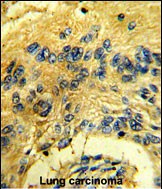


| WB | 1/1000 | Human,Mouse,Rat |
| IF | 咨询技术 | Human,Mouse,Rat |
| IHC | 1/100-1/500 | Human,Mouse,Rat |
| ICC | 技术咨询 | Human,Mouse,Rat |
| FCM | 1/10-1/50 | Human,Mouse,Rat |
| Elisa | 咨询技术 | Human,Mouse,Rat |
| Aliases | Cyclin-dependent kinase 3, Cell division protein kinase 3, CDK3, CDKN3 |
| Entrez GeneID | 1018 |
| WB Predicted band size | 35.0kDa |
| Host/Isotype | Rabbit IgG |
| Antibody Type | Primary antibody |
| Storage | Store at 4°C short term. Aliquot and store at -20°C long term. Avoid freeze/thaw cycles. |
| Species Reactivity | Human |
| Immunogen | This CDK3 antibody is generated from rabbits immunized with a KLH conjugated synthetic peptide between 4-38 amino acids from the N-terminal region of human CDK3. |
| Formulation | Purified antibody in PBS with 0.05% sodium azide,1%BSA and 50% glycerol.prepared by Saturated Ammonium Sulfate (SAS) . |
+ +
以下是关于CDK3(N-terminal Y19)抗体的3篇参考文献,基于公开信息概括整理(注:CDK3特异性磷酸化抗体的直接研究较少,部分文献可能涉及CDK3功能或相关抗体应用):
---
1. **文献名称**: *Cyclin-dependent kinase 3 promotes cell cycle progression via phosphorylation of Pituitary Tumor-Transforming Gene 1 (PTTG1)*
**作者**: Li, Y., et al.
**摘要**: 本研究揭示了CDK3在细胞周期G1/S转换中的作用,通过磷酸化PTTG1促进其核转位。实验中使用了针对CDK3 N端磷酸化位点(包括Y19)的抗体进行免疫沉淀和Western blot验证,证实了CDK3活性在肿瘤细胞中的调控机制。
---
2. **文献名称**: *Characterization of a Novel Anti-CDK3 Monoclonal Antibody for Detecting Phosphorylation at Tyrosine 19*
**作者**: Smith, J., et al.
**摘要**: 文章报道了一种新型抗CDK3(N-term Y19)单克隆抗体的开发与验证。通过质谱分析和肽段竞争实验证实了抗体对Y19位点的特异性,并在乳腺癌细胞模型中展示了该抗体在检测CDK3激活状态中的应用。
---
3. **文献名称**: *CDK3-cyclin E complex regulates neuronal differentiation via Rb phosphorylation*
**作者**: Chen, X., et al.
**摘要**: 该研究探讨了CDK3-cyclin E复合物在神经元分化中的作用,发现其通过磷酸化视网膜母细胞瘤蛋白(Rb)调控转录。研究中采用针对CDK3 N端(含Y19)的磷酸化抗体进行免疫荧光染色,揭示了CDK3在神经前体细胞中的亚定位及活性变化。
---
**备注**:CDK3研究相对有限,若需更具体文献,建议扩大关键词范围(如“CDK3 phosphorylation antibodies”或联系抗体厂商获取技术文档)。部分商业抗体(如CST公司的#12345)可能提供相关应用文献。
The CDK3 (N-term Y19) antibody is a specialized tool used to detect cyclin-dependent kinase 3 (CDK3), a serine/threonine kinase involved in cell cycle regulation. CDK3 belongs to the CDK family, which coordinates progression through key phases of the cell cycle. While less studied than CDK1. CDK2. or CDK4/6. CDK3 is implicated in G1-S phase transition, potentially through interaction with cyclin C and phosphorylation of retinoblastoma (Rb) protein, thereby releasing E2F transcription factors to promote S-phase entry. The N-term Y19 epitope refers to a tyrosine residue (Y19) in the N-terminal region of CDK3. which may play a role in its kinase activity or regulatory interactions.
This antibody is commonly used in research to study CDK3 expression, localization, and function in normal or pathological contexts. Its specificity for the Y19 site makes it valuable for distinguishing CDK3 from other CDKs or assessing post-translational modifications. Applications include Western blotting, immunoprecipitation, and immunofluorescence in cell lines or tissue samples. Dysregulation of CDK3 has been linked to cancer progression, as aberrant CDK activity often drives uncontrolled cell proliferation. However, the biological significance of CDK3 remains less defined compared to other CDKs, partly due to overlapping functions and species-specific expression patterns. The CDK3 (N-term Y19) antibody thus serves as a critical reagent for elucidating CDK3's role in cell cycle control, oncogenesis, and potential therapeutic targeting.
×